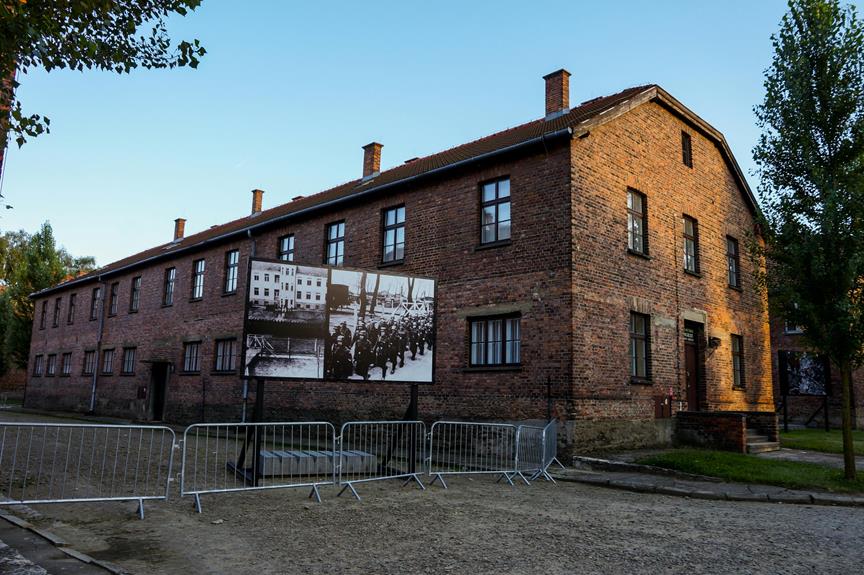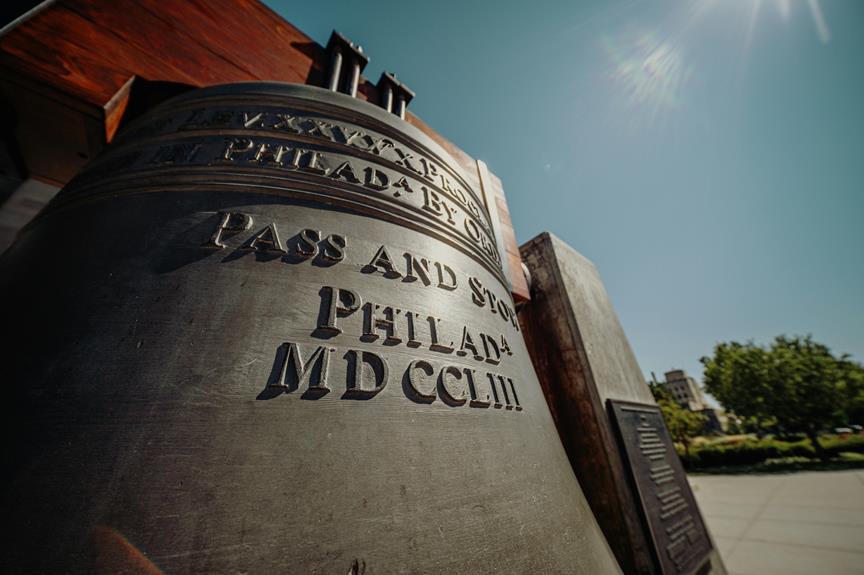The Imperial War Museum in the UK serves as a poignant reminder of the human cost of conflicts throughout history. As visitors traverse its halls, they are confronted with a profound reflection on the impact of war on society. Through meticulously curated exhibits and interactive displays, the museum offers a glimpse into the past that is both enlightening and thought-provoking. Whether exploring the personal stories of those affected by war or witnessing the architectural marvels within its walls, the museum presents a unique opportunity to gain insight into a complex and often sobering aspect of human history.
Key Takeaways
- Extensive collections of war memorabilia and military vehicles.
- Immersive virtual reality experiences for historical narratives.
- Rotating exhibitions and themed events for all ages.
- Located in the former Bethlem Royal Hospital in Southwark.
- Offers profound understanding of armed conflicts' impact on societies.
History of the Imperial War Museum
Founded in 1917 during World War I, the Imperial War Museum in the United Kingdom was established to document the military history and impacts of conflict on society. Its origins can be traced back to Sir Alfred Mond, who envisioned a national museum to preserve and commemorate the sacrifices made during the war. Initially located in the Crystal Palace at Sydenham Hill, the museum quickly outgrew its space, leading to its relocation to the former Bethlem Royal Hospital in Southwark.
The development of the Imperial War Museum saw it expanding its collection beyond World War I to include artifacts from World War II and subsequent conflicts. Over the years, the museum has undergone significant growth, both concerning physical space and outreach. In 1936, the HMS Belfast became part of the museum's collection, serving as a floating exhibit on the River Thames. This expansion allowed the museum to reach a wider audience and provide a more immersive experience of naval history.
Through various outreach programs and collaborations, the Imperial War Museum has solidified its position as a leading institution in documenting the history of warfare. Its commitment to preserving the past and educating the public about the realities of conflict continues to drive its mission of remembrance and understanding.
Notable Exhibits and Artifacts
The Imperial War Museum showcases a wide variety of notable exhibits and artifacts that offer an in-depth understanding of the history of warfare and its impact on society. Among the most significant displays are the extensive collections of war memorabilia and military vehicles, each with its own unique story to tell.
One of the key highlights of the museum is its collection of war memorabilia, including uniforms, medals, and personal items belonging to soldiers from various conflicts. These items provide a poignant glimpse into the lives of those who served on the front lines and offer a tangible connection to the past.
In addition to war memorabilia, the Imperial War Museum houses an impressive array of military vehicles that have played pivotal roles in different battles throughout history. From tanks and aircraft to artillery pieces, these vehicles stand as tangible reminders of the technological advancements and strategic innovations that have shaped the course of warfare.
Visitors to the museum can explore these exhibits in detail, gaining a deeper appreciation for the sacrifices made by those who fought in wars and the profound impact of armed conflicts on societies around the world. The artifacts on display serve as powerful educational tools, allowing visitors to engage with history in a meaningful and thought-provoking way.
Impact of War on Society
Warfare has undeniably left a lasting imprint on societies worldwide, shaping cultural norms, political landscapes, and social structures in profound ways. The impact of war on society extends beyond physical destruction; it explores the psychological effects and societal changes that reverberate long after conflicts cease.
Psychological effects resulting from war are multi-faceted. Post-traumatic stress disorder (PTSD) is a common consequence experienced by soldiers and civilians exposed to the horrors of war. The emotional toll of witnessing violence, death, and destruction can lead to long-term mental health challenges. Additionally, the desensitization to violence and the normalization of conflict can desensitize individuals to human suffering, affecting their empathy and emotional well-being.
Societal changes brought about by war are complex and enduring. Wars can alter power dynamics within a society, leading to shifts in political structures and governance. Additionally, wartime economies can reshape industries, labor markets, and trade relationships, impacting the livelihoods of individuals and communities. Social cohesion may also be disrupted, as divisions based on ethnicity, religion, or ideology are exacerbated during times of conflict.
Interactive Displays for Visitors
The exploration of interactive displays for visitors at the Imperial War Museum in the UK provides an immersive and educational experience that enhances understanding and engagement with the historical narratives of warfare. Through virtual reality experiences, visitors can step into the past and witness key moments in history firsthand. These experiences allow for a deeper connection to the events and the people involved, fostering empathy and a more profound appreciation for the sacrifices made.
Moreover, hands-on activities offer a tactile way for visitors to interact with artifacts and gain a tangible sense of the past. By touching and handling objects used during wartime, individuals can better comprehend the realities faced by those who lived through such tumultuous times. This interactive approach bridges the gap between the present and the past, making history come alive in a unique and compelling manner.
In addition to virtual reality experiences and hands-on activities, multimedia presentations and interactive workshops further enrich the visitor experience. These dynamic elements provide context, background information, and different perspectives on historical events, encouraging critical thinking and a more detailed understanding of the complexities of war. By engaging with these interactive displays, visitors are not mere spectators but active participants in the exploration of history.
Special Events and Exhibitions
Special events and exhibitions hosted at the Imperial War Museum in the UK showcase a diverse range of historical artifacts and narratives, providing visitors with a multifaceted insight into the complexities of global conflicts. These events offer a unique opportunity for visitors to engage with history in a dynamic and immersive way. Here are some highlights of the special events and exhibitions at the museum:
- Virtual Tours and Behind the Scenes Access: The museum offers virtual tours that allow visitors to explore its collections from the comfort of their homes. These tours provide a behind-the-scenes look at the museum's archives, conservation efforts, and research facilities. By exploring the unseen aspects of the museum, visitors can gain a deeper understanding of how history is preserved and presented.
- Family Activities and Themed Events: The Imperial War Museum organizes a variety of family-friendly activities and themed events throughout the year. From interactive workshops for children to special exhibitions designed for families, there are numerous opportunities for visitors of all ages to learn and engage with history together. These events aim to make the museum a welcoming and inclusive space for families to explore and discover together.
- Rotating Exhibitions and Temporary Displays: In addition to its permanent collections, the museum regularly hosts rotating exhibitions and temporary displays that delve into specific aspects of wartime history. These exhibitions often feature rare artifacts, personal stories, and interactive elements that bring history to life for visitors. By offering a diverse range of exhibitions, the museum makes sure that there is always something new and compelling for visitors to experience.
Educational Programs for Schools
Highlighting the educational initiatives tailored for schools, the Imperial War Museum in the UK offers extensive programs to enhance students' understanding of historical conflicts. The museum provides a range of educational resources and engaging activities such as student workshops and school tours, all designed to make history come alive for young learners.
Student workshops at the Imperial War Museum are interactive and thought-provoking. These workshops cover various topics related to war history, encouraging students to ask questions, participate in discussions, and even engage in hands-on activities. By actively involving students in the learning process, these workshops aim to deepen their understanding of the impact of war on society and individuals.
School tours offered by the museum provide students with the opportunity to explore different exhibitions and artifacts while making curriculum connections. Educators can tailor these tours to align with specific learning objectives, ensuring that students not only gain historical knowledge but also see how it relates to their classroom studies.
Furthermore, the Imperial War Museum's educational programs aim to foster critical thinking, empathy, and a deeper appreciation for the complexities of historical events. By providing immersive learning experiences, the museum helps students develop a more profound understanding of the past and its enduring relevance in today's world.
The War Through Personal Stories
Immersing visitors in poignant narratives of individuals impacted by historical conflicts, the Imperial War Museum in the UK explores deeply into 'The War Through Personal Stories'. This section of the museum explores the human experiences behind the wars, shedding light on the personal narratives that often get overshadowed by the grandeur of historical events. Through a variety of mediums such as letters, diaries, and recorded testimonies, visitors can connect on a more emotional level with the realities of war.
In this section, the museum highlights:
- Individual Accounts: Visitors encounter firsthand personal accounts of soldiers, civilians, and other individuals affected by war. These personal narratives provide a glimpse into the emotional turmoil, sacrifices, and resilience displayed by those who lived through turbulent times.
- Interactive Exhibits: Interactive exhibits allow visitors to engage with the personal stories in a more immersive way. Through multimedia presentations, visitors can listen to audio recordings, watch videos, and even participate in simulated experiences that mirror the challenges faced by individuals during wartime.
- Legacy and Impact: The exhibition not only focuses on the experiences during the conflicts but also explores the lasting impact on individuals and communities long after the wars have ended. It prompts visitors to reflect on the broader implications of war on society and the importance of preserving personal narratives for future generations to understand the true cost of conflict.
Architecture and Design Highlights
Exploring the Imperial War Museum's 'Architecture and Design Highlights' provides a unique lens through which to appreciate the structural elements that contribute to the museum's immersive narrative experience. The museum, housed in the former Bedlam psychiatric hospital, showcases architectural innovation through the seamless integration of historical elements with modern design aesthetics.
One of the standout features is the Central Atrium, a vast space that serves as the heart of the museum. The Atrium's soaring glass walls flood the area with natural light, creating a sense of openness and reflection. This architectural choice not only enhances the visitor's experience but also symbolizes transparency and the museum's commitment to truth and understanding.
Moreover, the use of industrial materials such as concrete and steel pays homage to the building's history while providing a contemporary backdrop for the exhibitions. The juxtaposition of old and new highlights the museum's mission to bridge the past with the present.
In terms of design aesthetics, the museum's galleries are thoughtfully curated to guide visitors through a chronological journey of conflict. The layout and spatial design create a sense of progression, leading visitors through different eras and perspectives. Overall, the Imperial War Museum's architecture and design not only serve as a backdrop for historical artifacts but also play an important role in shaping the visitor's emotional and intellectual engagement with the exhibits.
Museum Shop and Cafes
The Imperial War Museum features a Museum Shop and Cafes that offer visitors a range of options for relaxation and browsing after their exploration of the museum's exhibits. The offerings at the Museum Shop and Cafes are crafted to enhance the overall visitor experience.
Museum Shop and Cafes Highlights:
- Merchandise Selection: The Museum Shop boasts a diverse array of merchandise, including books, replicas, historical memorabilia, and unique gifts. Visitors can choose from a wide selection of items that serve as meaningful reminders of their visit or as gifts for history enthusiasts. The shop guarantees there are options for every taste and budget, making it a popular stop for visitors.
- Culinary Offerings: The cafes at the Imperial War Museum provide a delightful dining experience for visitors looking to refuel after exploring the museum. From light snacks to hearty meals, the cafes offer a variety of options to cater to different preferences. Whether visitors seek a quick bite or a leisurely meal, the cafes provide a welcoming ambiance to relax and enjoy a culinary treat.
- Souvenir Options: The Museum Shop offers an extensive range of souvenirs that capture the essence of the museum and its exhibits. These souvenirs serve as keepsakes for visitors to cherish their museum experience. With items ranging from keychains to clothing, visitors can find the perfect memento to take home and commemorate their visit to the Imperial War Museum.
Planning Your Visit to the Museum
Upon entering the Imperial War Museum, visitors are encouraged to carefully plan their visit to make the most of the diverse exhibitions and experiences available. To guarantee the visitor experience, the museum offers various accessibility features to make sure that all guests can enjoy the collections and displays.
For those planning a visit, it is advisable to check the museum's website for updated information on opening hours, special exhibitions, and any temporary closures. The museum provides ample parking facilities for visitors arriving by car, and it is easily accessible by public transport, with several bus stops and train stations in close proximity.
Upon arrival, visitors can make use of the museum's amenities, including restrooms, cloakrooms, and a café to grab a refreshment during their visit. The museum also offers guided tours and interactive exhibits to enrich the visitor experience further.
To make the most of your time at the Imperial War Museum, consider picking up a map or guide at the entrance to help navigate the extensive galleries and displays. Additionally, the museum has friendly and knowledgeable staff who are readily available to assist visitors with any inquiries or provide recommendations for must-see exhibits.
Frequently Asked Questions
Are There Any Restrictions on Photography Inside the Museum?
Photography restrictions within museums vary depending on the establishment's rules and policies.
While some museums allow photography without limitations, others may impose restrictions to guarantee the preservation of artifacts, protect intellectual property rights, or maintain the visitor experience.
It is essential for visitors to familiarize themselves with the specific photography guidelines of each museum they visit to avoid any potential disruptions or infringements.
Can Visitors Bring Their Own Food and Drinks?
Visitors often explore food options when planning their visits to museums, taking into account factors like dietary preferences and convenience. Access to picnic areas or the ability to bring their own food and drinks can greatly enhance the overall experience. Providing these amenities can accommodate visitors' needs and preferences, allowing for a more enjoyable and personalized visit.
It is crucial for museums to prioritize the freedom and comfort of their guests when it comes to food and beverage options.
Is There a Designated Area for Storing Luggage or Bags?
Luggage storage and bag policies are important considerations for visitors seeking convenience and security. Dedicated areas for storing luggage provide a hassle-free experience, allowing visitors to explore freely without the burden of carrying bags.
Understanding the museum's policies regarding bag size, prohibited items, and storage locations is vital for a smooth visit. By adhering to these guidelines, visitors can maximize their enjoyment while maintaining a safe and organized environment within the museum premises.
Are There Any Guided Tours Available for Visitors?
Guided tours provide visitors with in-depth insights into the historical significance of interactive exhibits and historical artifacts. These tours offer a structured exploration of the museum's collections, allowing participants to gain a deeper understanding of the context and stories behind each exhibit.
Professional guides enhance the visitor experience by providing detailed explanations and facilitating a more thorough and informative visit. Guided tours offer a unique opportunity to explore the museum's offerings in a detailed and educational manner.
Is the Museum Wheelchair Accessible?
Wheelchair accessibility is an important aspect of ensuring inclusivity in public spaces. Museums, as cultural institutions, often face challenges in providing sufficient accessibility for visitors with mobility impairments.
Evaluating museum facilities for wheelchair accessibility involves examining entrance ramps, door widths, elevator access, and restroom facilities. Understanding the needs of individuals with disabilities is essential in creating a welcoming and accommodating environment for all visitors.
Conclusion
To sum up, a visit to the Imperial War Museum in the UK offers a thought-provoking exploration of the profound impacts of conflicts on society.
Through its extensive collections, interactive displays, and personal stories, the museum provides a powerful reminder of the consequences of war.
Despite the harrowing subject matter, the museum's engaging exhibitions and immersive experiences guarantee a compelling and educational visit for all.


